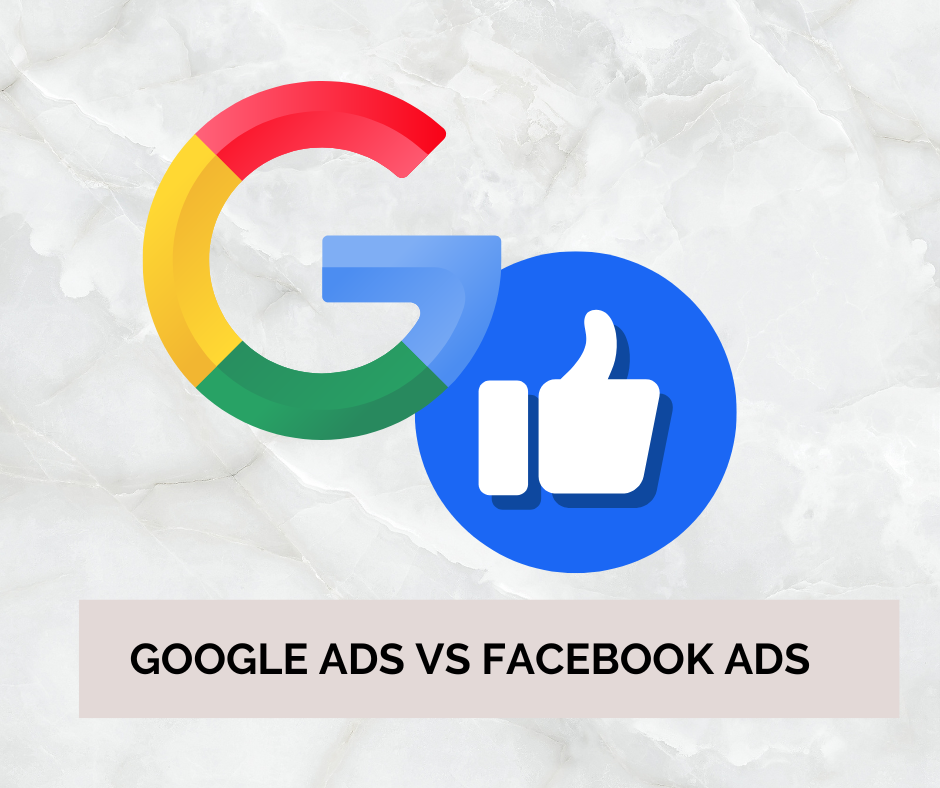Online advertising is essential for businesses looking to grow their audience, generate leads, and increase sales. Two of the most dominant platforms in digital advertising are Google Ads and Facebook Ads. Both offer powerful tools, but they work in different ways and serve different business goals. Choosing between the two depends on factors like audience behavior, campaign objectives, and budget.
This article explores the key differences, strengths, and best-use cases of Google Ads vs. Facebook Ads. By the end, you’ll have a clear understanding of which platform suits your business needs best and how to use them effectively.
Google Ads vs. Facebook Ads: Understanding the Key Differences
Both platforms offer excellent advertising opportunities, but they operate differently. Google Ads focuses on search intent, while Facebook Ads excel in audience engagement and social discovery. Understanding these fundamental differences will help businesses allocate their advertising budget more effectively.
Google Ads: Capturing High-Intent Buyers
Google Ads works on a pay-per-click (PPC) model, displaying ads when users search for specific keywords. Because users are actively searching for solutions, Google Ads are great for driving conversions. Businesses that rely on direct response marketing benefit the most.
Additionally, Google provides multiple ad types, including text ads, display ads, shopping ads, and video ads. These options allow businesses to create highly relevant campaigns targeting users based on search queries and intent. Google also provides robust tools like Smart Bidding, which helps advertisers optimize their campaigns using machine learning to improve conversions and ROI.
Facebook Ads: Engaging Users Through Social Targeting
Facebook Ads, on the other hand, focus on reaching users based on their interests, behaviors, and demographics. Unlike Google, where users actively search for solutions, Facebook Ads introduce products and services to users who may not yet realize they need them. This makes them perfect for brand awareness and audience building.
Another advantage of Facebook Ads is its vast visual formats. Businesses can create compelling image ads, video ads, and interactive story ads to engage audiences dynamically. The platform also offers advanced audience segmentation and lookalike targeting, allowing advertisers to expand their reach effectively.
Furthermore, Facebook’s engagement-based approach makes it an excellent tool for retargeting. Businesses can reconnect with users who have previously interacted with their brand, nurturing leads and driving them toward conversion.
Targeting Capabilities: Which Platform Reaches the Right Audience?
A key difference between the two platforms is their targeting methods. Google Ads prioritize keyword-based targeting, while Facebook Ads leverage behavioral and demographic targeting.
Google Ads: Intent-Driven Targeting
Google Ads allows advertisers to target users based on search queries. The platform offers different match types to refine targeting:
- Broad Match: Displays ads for variations of a keyword.
- Phrase Match: Shows ads when the search includes a keyword phrase.
- Exact Match: Limits ads to searches that closely match the keyword.
Additionally, Google offers retargeting options and demographic filtering, but its primary strength lies in keyword targeting.
By leveraging Google’s intent-based targeting, businesses can ensure their ads appear when users are actively searching for specific solutions, making it a great platform for direct response campaigns.
Facebook Ads: Behavioral and Interest-Based Targeting
Facebook Ads use detailed user data to create hyper-targeted campaigns. Advertisers can target based on:
- Demographics: Age, gender, location, job title, relationship status.
- Interests: Hobbies, pages liked, shopping behavior.
- Lookalike Audiences: Expands users’ reach similar to existing customers.
Facebook excels at finding new audiences and nurturing them through engaging content. The ability to create custom audiences allows businesses to refine their ad delivery, ensuring they reach users who are more likely to engage with their brand.
Cost and ROI: Which Offers Better Value for Your Budget?
Budgeting plays a crucial role in advertising strategy. Google Ads and Facebook Ads have different cost structures and returns on investment (ROI).
Google Ads: Higher CPC, Faster Conversions
Google Ads often have a higher cost-per-click (CPC) since they target high-intent users. The average CPC varies by industry, but it tends to be more expensive than Facebook. However, businesses that focus on lead generation or e-commerce often see a strong return on investment due to faster conversions.
Since Google Ads capture users with immediate purchasing intent, businesses investing in PPC campaigns often experience higher conversion rates, making up for the higher CPC.
Facebook Ads: Lower CPC, Higher Engagement
Facebook Ads generally have a lower CPC compared to Google. However, because users are not actively searching for products, conversions may take longer. Facebook campaigns are excellent for businesses looking to build awareness, grow an audience, and nurture leads over time.
While Facebook Ads may require more touchpoints before a conversion, its visual appeal and engagement-driven approach make it an effective channel for storytelling and long-term brand growth.
Ad Formats: What Works Best for Your Campaign Goals?
Both platforms offer various ad formats tailored to different business objectives.
Google Ads: Search, Display & YouTube Ads
- Search Ads: Text-based ads appearing on Google search results.
- Display Ads: Banner ads are shown on Google’s display network.
- Shopping Ads: Product listings displayed for relevant searches.
- YouTube Ads: Video ads before or during YouTube videos.
Google Ads work best for businesses that want immediate traffic and conversions.
Facebook Ads: Carousel, Video, and Story Ads
- Image Ads: Simple, high-quality visuals with a clear call to action.
- Carousel Ads: Showcase multiple images or videos in a single ad.
- Video Ads: High-engagement format ideal for storytelling.
- Story Ads: Full-screen mobile ads optimized for quick engagement.
Facebook Ads work well for businesses looking to increase brand awareness and engagement.
Conclusion
Both Google Ads vs. Facebook Ads offer powerful advertising opportunities. Google Ads work best for businesses targeting high-intent buyers, while Facebook Ads excel at audience engagement and brand building. The right choice depends on your business goals, budget, and target audience. For maximum impact, consider integrating both platforms into your marketing strategy.
FAQs
1. Are Facebook Ads cheaper than Google Ads?
Yes, Facebook Ads usually have a lower CPC than Google Ads. However, Google Ads often drive faster conversions since users actively search for products or services.
2. Can I use both Google Ads and Facebook Ads together?
Absolutely. Combining both platforms helps businesses capture high-intent searches with Google Ads while building brand awareness and engagement through Facebook Ads.
3. Which platform is better for lead generation?
Google Ads work best for capturing immediate leads through search intent. Facebook Ads help nurture leads through engaging content and retargeting strategies.
By understanding the strengths of both platforms, you can make a well-informed decision and maximize your advertising success.
Need help in launching a successful PPC ads campaign? At Backend Teams, we have PPC plans to help you kickstart your Google ads or Facebook ads campaign.

